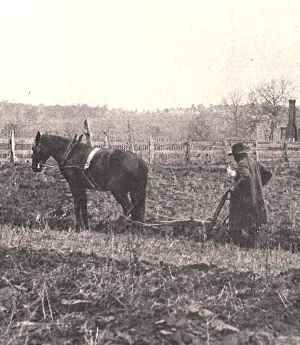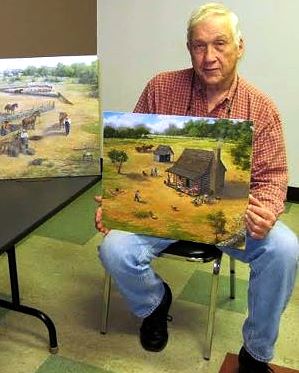Reconstructing Life on the Williams Farmstead
|
It is difficult for us, living in a modern world full of machines and labor-saving technology, to envision what life was like on a rural farm in the late nineteenth century. The percentage of Texans living in rural areas has decreased dramatically over the last century, and many modern Texas have never seen a working farm or ranch let alone lived or worked on one. Even for people who are involved in agriculture today, modern technological advances have completely changed the way farms and ranches operate. Operating a small farm in 1895 using horse-drawn equipment and simple hand tools was a different type of lifestyle than on today’s fully mechanized farms. For most farm families, it was a backbreaking job, from dawn to dark. For this project, we wanted to illustrate what life was like for the Williams family living on their small farm near the end of the nineteenth century. To do this, we turned to Austin artist Frank Weir. Dr. Weir has more than just a passing interest in history. He holds a Ph.D. in Anthropology from Washington State University and headed up the archeology program at the Texas Department of Transportation for over 25 years. We commissioned Weir to create three paintings that would depict different scenes on the Williams farm, and we wanted the images to be as historically accurate as possible. Prewitt and Associates archeologists worked closely with Frank to provide archeological information on site layout, features, and recovered artifacts so that realistic details could be incorporated into each scene. We chose the year 1895 as the historical setting for all three of the lifestyle reconstruction paintings. This was 24 years after Ransom bought the property, and his farming operation was well established by then. We depicted the people and activities based on information from archeological research and historical documents. In 1895, Ransom was 49 years old and his wife, Sarah, 44. As far as we know, seven of their children were living on the farm at that time: Will, 19; Charley, 17; Mary, 13; Henry, 12; Mattie, 10; John, 6; and Emma, 3. The objects and activities depicted in the paintings are all represented by one or more artifacts found during farmstead investigations. The horse-drawn wagons shown in two of the paintings, for example, are represented by dozens of wagon parts and many pieces of harness equipment. The year 1895 also represents the heyday of the Williams farmstead, in many respects. Only five years later the oldest son, Will, got married and moved away. Ransom died that year at the presumed age of 55. With these changes in the family dynamics at the turn of the century, the rest of the family moved off the farm by 1905. By clicking on each of the three paintings above, you will be able to see details in the scene and learn more about what is depicted. An interactive version of these scenes, showing many of the actual artifacts on which the paintings were based, can be viewed in the exhibit section, Kids: Discover a 19th-Century Farm. |
|

